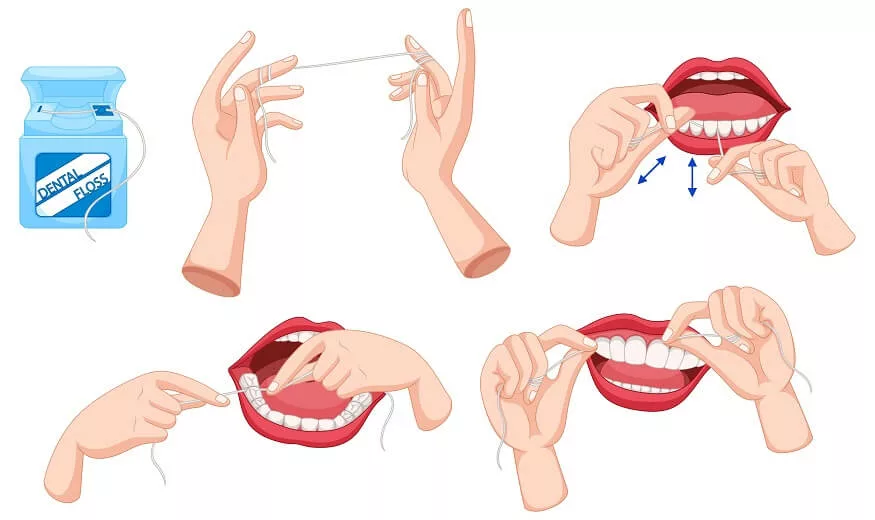As parents, caregivers, or educators, ensuring the dental health of children is a fundamental aspect of their overall well-being. One often overlooked yet crucial practice in oral hygiene is flossing. In this article by EuroSchool, we delve into the crucial topic of flossing for kids, exploring its importance, benefits, and methods.
Flossing for Children: Meaning
Flossing is the process of using a thin piece of string, known as dental floss, to clean between the teeth where toothbrushes may struggle to reach. For children, the importance of flossing cannot be overstated, considering the unique vulnerabilities of their developing teeth.
When it comes to understanding the essence of flossing for children, it’s imperative to recognise that toothbrushes, no matter how efficient, can’t thoroughly clean the spaces between teeth. These interdental areas are havens for bacteria and food particles, which, if left unattended, can lead to various dental issues. Flossing, therefore, serves as the unsung hero in the battle against cavities and gum diseases, ensuring a child’s smile remains bright and healthy.
Also Read: Guide to Braces for Kids – Dental health for kids with braces
Importance of Flossing Teeth for Children
The importance of flossing teeth for children cannot be overstated, as it plays a pivotal role in safeguarding their dental health. Flossing goes beyond the routine of brushing, addressing the unique challenges posed by the tight spaces between teeth. Children, in particular, benefit from flossing due to the vulnerability of their developing teeth and gums. Toothbrushes, while effective on tooth surfaces, often struggle to reach the intricate spaces between teeth where food particles and bacteria hide. Flossing becomes a key player in the fight against dental issues by meticulously removing debris from these interdental spaces, ensuring a comprehensive clean. Here are the importance of flossing teeth for children.
Comprehensive Cleaning
- Goes beyond regular brushing to reach tight spaces between teeth.
- Removes plaque and bacteria from interdental areas, preventing cavities and gum disease.
- Addresses the vulnerability of children’s developing teeth and gums.
- Toothbrushes may struggle to reach intricate spaces, making flossing essential.
- Acts as a proactive measure against the buildup of plaque.
- Plaque can harden into tartar, leading to dental issues if not addressed.
- Sets the foundation for a lifetime of good oral hygiene practices.
- Children learning to floss early are likely to carry the discipline into adulthood.
- Prevents inflammation and promotes overall gum health.
- Addresses the unique vulnerabilities of children’s gums.
- Eliminates food particles that can lead to bad breath.
- Promotes fresh breath and boosts the child’s confidence.
- Especially important for children with braces or orthodontic appliances.
- Maintains cleanliness around orthodontic devices, preventing complications.
- Offers a targeted and meticulous approach to oral hygiene.
- Flossing complements regular brushing for a more comprehensive clean.
- Teaches children to take responsibility for their oral health.
- Fosters independence in their dental care routine.
- Instil habits that contribute to a lifetime of healthy smiles.
- Reduces the risk of dental issues in adulthood through consistent flossing.
Vital for Developing Teeth
Prevents Plaque Buildup
Establishes Good Habits
Contributes to Gum Health
Enhances Fresh Breath
Crucial for Orthodontic Care
Proactive Oral Hygiene
Encourages Independence
Long-Term Oral Health Benefits
Also Read: Childhood Dental Health and Nutrition: Foods that protect and harm young teeth
Benefits of Flossing Teeth for Children
The benefits of flossing for children extend beyond the immediate advantages of cavity prevention. Here are some key benefits that underscore the significance of incorporating flossing into a child’s oral care routine:
- Prevention of Cavities:
- Gum Health:
- Development of Good Oral Habits:
- Fresh Breath:
- Orthodontic Care:
- Enhanced Aesthetic Appeal:
Flossing removes food particles and bacteria from between teeth, preventing the formation of plaque and reducing the risk of cavities.
Flossing helps maintain healthy gums by preventing gum disease. Gum health is vital for overall oral well-being and can impact a child’s systemic health as well.
Introducing flossing to children establishes a foundation for a lifetime of good oral hygiene practices. Starting early ensures that these habits become second nature as they grow older.
By eliminating the food particles that can lead to bad breath, flossing contributes to maintaining fresh and pleasant breath in children.
Children with braces or other orthodontic appliances face additional challenges in cleaning their teeth. Flossing becomes even more critical in these cases, preventing complications such as decay and inflammation around orthodontic devices.
Flossing contributes to a cleaner and brighter smile. The aesthetic aspect is especially important for children, fostering confidence and positive self-image.
Also Read: Understanding Oral Thrush In Infants: Causes, Symptoms, And Remedies
Methods of Flossing Teeth for Children
Now that we’ve established the importance and benefits of flossing for children, let’s delve into the practical aspect – how to floss effectively and make it a positive experience for children:
Choose the Right Floss
Opt for soft, flexible floss specifically designed for children. Flavoured floss can make the experience more enjoyable for kids.
Demonstrate Proper Technique
Show children how to hold the floss between their fingers, guiding them through the process. Emphasise the importance of being gentle to avoid causing discomfort or damaging the gums.
Make it Fun
Turn flossing into a game or incorporate it into a daily routine. For example, flossing can be part of a morning or bedtime “tooth care challenge.” Use child-friendly flossing tools or colourful dental floss to make the activity more appealing.
Supervise Initially
For younger children, supervise their flossing initially to ensure they grasp the technique. Gradually grant more independence as they become comfortable with the routine.
Establish a Routine
Make flossing a regular part of the daily oral care routine. Consistency is key to developing and maintaining good oral hygiene habits.
Positive Reinforcement
Praise children for their efforts in flossing and emphasise the positive outcomes, such as a healthier smile and fresher breath. Consider implementing a reward system to further motivate them.
Use Flossing Aids
Flossing aids, such as floss picks or interdental brushes, can be more manageable for children, especially those with braces or tight teeth.
Also Read: What is Dental care: Importance, Causes, Remedies
The importance of flossing for children cannot be overstated. It is a simple yet powerful practice that contributes significantly to their overall oral health. EuroSchool understands the benefits of flossing and incorporating it into a child’s routine from an early age and encourages parents and caregivers to play a vital role in setting the stage for a lifetime of healthy smiles.











